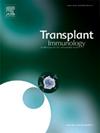Immune reconstitution with high-dose chemotherapy and autologous stem cell transplantation in refractory and relapsed Hodgkin lymphoma: Prognostic factors and outcome from a single-center experience
IF 1.4
4区 医学
Q4 IMMUNOLOGY
引用次数: 0
Abstract
Background
Autologous stem cell transplantation (ASCT) imposes significant immunogenic effects that may also underlie some of its anti-tumor effectiveness. Despite improvements in disease risk stratification and treatment approaches with high cure and response rate for newly diagnosed Hodgkin lymphoma (HL) with initial therapy in most patients, a significant proportion will be experiencing refractory or relapsed (R/R) following the initial front-line therapy. A high-dose chemotherapy followed by ASCT remains the standard treatment for relapsed Hodgkin disease in adult patients. The aim of our study was to identify the impact of ASCT on outcomes in R/R HL, considering various pre- and post-ASCT parameters as prognostic predictors, including disease status response, time of absolute neutrophils, and lymphocyte recovery counts post ASCT.
Methods
We retrospectively investigated data of 118 patients with R/RHL from January 2014 to December 2022, whose ages ranged from 7 to 58 years old. The recorded data included: the early response type and mortality rate, at day 100 post-ASCT, as well as the end of the study outcomes such as survival, relapse, and mortality status. Patients were grouped according to gender, disease status pre-ASCT, number of chemotherapy protocols that were given pre-ASCT, time of absolute neutrophils and lymphocyte recovery counts post-ASCT.
Results
The mean age of our included patients was 25.1 (7–58) years. The male to female ratio was1.2:1with a mean duration of disease follow-up was 74.2 months. The mean duration time of absolute neutrophil and lymphocyte recovery count post-ASCT day was 11 ± 2.9 and 13 ± 2.6 days respectively. The outcome at 100 days post-ASCT was: 89.8 % of the patients showed complete remission, 6.8 % showed no response, and 3.4 % deceased. The three-year overall survival (OS) rate was 88.5 %, while the event free survival (EFS) rate was 72 %. Regarding the three-year EFS rate for patient with complete remission was 91 %, for patients with uncertain complete response was 71 %, also 71 % for partial remission and 45 % for stable disease. The EFS rate in relation to the number of chemotherapy protocols at three-year follow up was 80 % and 66 % for patients with ≥2 chemotherapy lines(P = 0.03).
Conclusion
Autologous stem cell transplantation for R/R HL patients demonstrated a significant favorable outcome in terms of the overall survival rate and the progression-free disease, especially among those who exhibited earlier response to salvage chemotherapy at the pre-transplantation stage and unrelated to time of absolute neutrophil and lymphocyte recovery count.
顽固性和复发性霍奇金淋巴瘤的免疫重建与大剂量化疗和自体干细胞移植:来自单中心经验的预后因素和结果
背景:自体干细胞移植(ASCT)具有显著的免疫原性效应,这也可能是其抗肿瘤有效性的基础。尽管疾病风险分层有所改善,新诊断的霍奇金淋巴瘤(HL)的治疗方法在大多数患者的初始治疗中具有高治愈率和应答率,但在初始一线治疗后,仍有相当大比例的患者将经历难治性或复发(R/R)。高剂量化疗后ASCT仍然是成人复发霍奇金病患者的标准治疗方法。本研究的目的是确定ASCT对R/R HL预后的影响,考虑ASCT前后的各种参数作为预后预测因子,包括疾病状态反应、绝对中性粒细胞时间和ASCT后淋巴细胞恢复计数。方法:回顾性分析2014年1月至2022年12月118例R/RHL患者的资料,年龄7 ~ 58岁 。记录的数据包括:asct后第100天的早期反应类型和死亡率,以及研究结束时的生存、复发和死亡率状况。患者根据性别、asct前的疾病状态、asct前给予的化疗方案数量、绝对中性粒细胞时间和asct后淋巴细胞恢复计数进行分组。结果:我们纳入的患者平均年龄为25.1(7-58)岁。男女比例为1.2:1,平均疾病随访时间为74.2 个月。asct后绝对中性粒细胞和淋巴细胞恢复计数的平均持续时间分别为11 ± 2.9天和13 ± 2.6 天。asct后100 天的结果是:89.8% %的患者完全缓解,6.8 %的患者无反应,3.4 %的患者死亡。三年总生存率(OS)为88.5 %,无事件生存率(EFS)为72 %。完全缓解患者的3年EFS率为91 %,完全缓解不确定患者的3年EFS率为71 %,部分缓解患者的3年EFS率为71 %,疾病稳定患者的3年EFS率为45 %。3年随访时,有≥2种化疗方案的患者的EFS率与化疗方案数量的关系为80 %和66 % (P = 0.03)。结论:自体干细胞移植治疗R/R HL患者在总生存率和无进展疾病方面表现出显著的有利结果,特别是在移植前阶段对补救性化疗反应较早且与绝对中性粒细胞和淋巴细胞恢复计数时间无关的患者。
本文章由计算机程序翻译,如有差异,请以英文原文为准。
求助全文
约1分钟内获得全文
求助全文
来源期刊

Transplant immunology
医学-免疫学
CiteScore
2.10
自引率
13.30%
发文量
198
审稿时长
48 days
期刊介绍:
Transplant Immunology will publish up-to-date information on all aspects of the broad field it encompasses. The journal will be directed at (basic) scientists, tissue typers, transplant physicians and surgeons, and research and data on all immunological aspects of organ-, tissue- and (haematopoietic) stem cell transplantation are of potential interest to the readers of Transplant Immunology. Original papers, Review articles and Hypotheses will be considered for publication and submitted manuscripts will be rapidly peer-reviewed and published. They will be judged on the basis of scientific merit, originality, timeliness and quality.
 求助内容:
求助内容: 应助结果提醒方式:
应助结果提醒方式:


